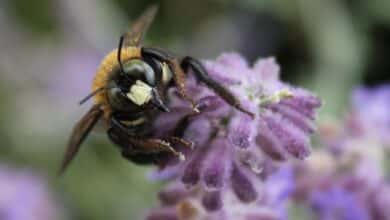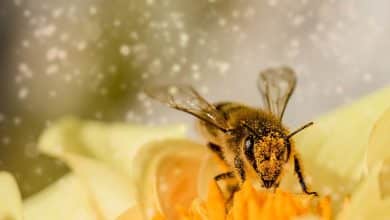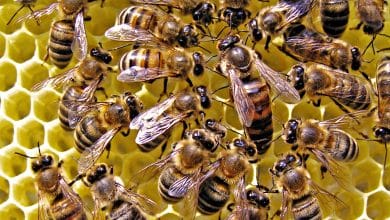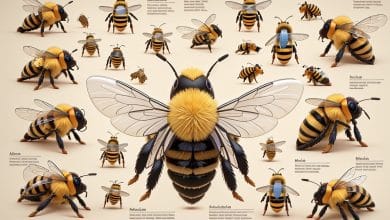The Basics of Keeping Bees A Beginner Guide

Beekeeping is a rewarding and fascinating hobby that allows individuals to connect with nature while also making a positive impact on the environment. By keeping bees, you can contribute to the pollination of plants and help support the health of our ecosystems. But beekeeping is not just beneficial for the environment; it also offers numerous advantages for those who take up this hobby.
For beginners interested in beekeeping, it’s essential to understand the basics before diving in. This guide aims to provide all the necessary information to get started on your beekeeping journey. Whether you have a small backyard or ample land, anyone can become a beekeeper with some preparation and dedication.
Throughout this guide, we will cover topics such as choosing the right hive equipment, selecting an ideal bee species, hive management techniques, harvesting honey and dealing with common challenges that may arise.
Additionally, we’ll address common questions that often arise when considering beekeeping. Is it difficult to keep bees? Are bees worth keeping? Is beekeeping an expensive hobby? Is keeping bees a daily commitment?
By following this beginner’s guide and utilizing additional resources available for novice beekeepers, you’ll be well-equipped to embark on your exciting journey into the world of beekeeping. So let’s dive in and discover how you can become a successful beekeeper!
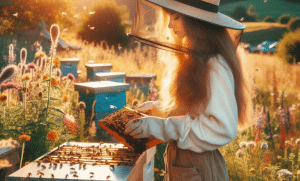
Why Keep Bees
Importance of Beekeeping for the Environment
Beekeeping plays a crucial role in supporting the environment and our ecosystems. Bees are essential pollinators, responsible for fertilizing flowers and enabling plants to reproduce. They play a vital part in the growth of fruits, vegetables, nuts, and seeds that make up a significant portion of our diets.
By keeping bees, you can actively contribute to the preservation of biodiversity. As bees collect nectar from various flowering plants, they transfer pollen from one flower to another. This process helps facilitate cross-pollination and enhances genetic diversity within plant populations.
Additionally, beekeeping helps combat the decline in bee populations worldwide. Bees face numerous challenges such as habitat loss, pesticide exposure, and disease. By providing safe havens for bees through well-managed hives, beekeepers help safeguard these vital pollinators.
Furthermore, healthy bee populations benefit other wildlife by providing food sources and supporting ecosystem balance. Bees also contribute to the production of honey and beeswax—natural resources used in various industries such as food production, cosmetics, and candle-making.
Overall, beekeeping is not only a rewarding hobby but also an important practice for maintaining environmental health. By becoming a beekeeper, you can actively participate in conserving nature’s delicate balance while enjoying the sweet rewards of honey production.
Benefits of Keeping Bees as a Hobby
Keeping bees as a hobby offers numerous benefits beyond just the satisfaction of learning and caring for these fascinating creatures. Here are some key advantages to consider:
- Connection with Nature: Beekeeping allows you to immerse yourself in the natural world. You’ll witness firsthand the intricate workings of a beehive, observe the bees’ behavior, and gain a deeper understanding of their role in our ecosystem.
- Educational Opportunity: Beekeeping is a continuous learning experience that provides valuable insights into biology, ecology, and environmental sustainability. It’s an excellent way to educate yourself and others about the importance of pollinators and their impact on food production.
- Stress Relief: Spending time with bees can be incredibly calming and meditative. The rhythmic hum of the hive and the gentle movements of the bees can help reduce stress levels, promote mindfulness, and improve your overall well-being.
- Delicious Rewards: One of the most exciting aspects of beekeeping is harvesting your own honey! Enjoying freshly harvested honeycomb or sharing jars of golden goodness with friends and family is a sweet reward for your efforts.
- Environmental Impact: By providing safe havens for bees in your backyard or community, you’re actively contributing to conservation efforts aimed at protecting these vital pollinators. Your small-scale beekeeping operation can have a positive impact on local biodiversity by supporting plant growth through cross-pollination.
- Sustainable Living: Beekeeping aligns with sustainable living practices since it promotes self-sufficiency through honey production while reducing reliance on store-bought alternatives.
Overall, keeping bees as a hobby enriches your life by connecting you with nature, providing educational opportunities, offering stress relief, rewarding you with delicious honey, making an environmental impact, and promoting sustainable living practices
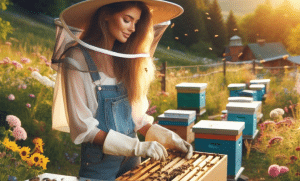
Getting Started with Beekeeping
Beekeeping is an exciting and rewarding hobby that anyone can start with the right knowledge and equipment. Here are some essential steps to help you get started on your beekeeping journey:
- Choose the Right Hive Equipment: Selecting the right hive is crucial for the success of your beekeeping venture. The two most common types are Langstroth hives and top-bar hives. Consider factors such as cost, maintenance, and local regulations when making your decision.
- Select the Ideal Bee Species: Honey bees come in various species, each with its own characteristics. The most popular species for beginner beekeepers is the Italian honey bee due to its gentle nature and high honey production.
- Obtain Bees: You have two options for obtaining bees – purchasing a package of bees or buying a nucleus colony (nuc). Packages consist of approximately 10,000 bees and a queen, while nucs contain established colonies with brood, workers, and a queen.
- Gather Beekeeping Supplies: There are essential tools and equipment you’ll need to properly care for your bees, including a smoker, hive tool, protective clothing (bee suit or veil), gloves, feeder, frames, and foundation.
- Install Bees in Your Hive: Once you have your hive set up and ready to go, it’s time to introduce your bees to their new home. Follow proper installation techniques to ensure a smooth transition for your colony.
- Perform Regular Hive Checks: Regular inspections of your hive will help you monitor the health of your bees and identify any issues that may arise. Look out for signs of disease or pests during these checks.
- Keep Records: Maintaining a beekeeping journal will allow you to track important information about your hive’s progress over time – from population growth to honey production.
- Harvest Honey: As an aspiring beekeeper, one of the most rewarding experiences is harvesting honey from your own hive. Learn the proper techniques for extracting and storing honey to enjoy the fruits of your labor.
Remember, beekeeping requires ongoing learning and dedication. By following these steps, you’ll be well on your way to becoming a successful beekeeper.
Choosing the Right Hive Equipment
Choosing the right hive equipment is crucial for a successful beekeeping venture. There are different types of hives available, but the most common options are Langstroth hives and top-bar hives.
Langstroth hives consist of stackable boxes with frames that allow bees to build comb and store honey. These hives are popular among beekeepers due to their versatility and ease of use. They also provide excellent insulation for the bees during colder months.
On the other hand, top-bar hives have bars instead of frames, allowing bees to build natural comb without any foundation. These hives require less maintenance and are ideal for those seeking a more natural approach to beekeeping.
When choosing your hive equipment, consider factors such as cost, maintenance requirements, and local regulations. It’s important to ensure that your chosen hive is suitable for your specific needs and environment.
In addition to the hive itself, you will need other essential tools such as a good hive tool and a smoker. Other optional but handy equipment includes protective clothing (bee suit or veil), gloves, feeders, frames, and foundation.
By selecting the right hive equipment, you will set yourself up for success in your beekeeping journey. Remember to research and consult experienced beekeepers before making any purchases to ensure you make informed decisions about your setup.
Selecting the Ideal Bee Species
When it comes to selecting the ideal bee species for your beekeeping venture, there are a few options to consider. The most common and widely recommended species for beginners is the Western honeybee (Apis mellifera). These bees are known for their gentle nature, high productivity, and ability to adapt to various climates.
However, there are also other bee species that you can choose from based on your specific needs. For example, if you live in a colder climate, you might consider the Carniolan honeybee (Apis mellifera carnica) or the Russian honeybee (Apis mellifera caucasica), as they are more tolerant of colder temperatures.
Another factor to consider when selecting a bee species is disease resistance. Some bees have shown greater resistance to certain diseases such as varroa mites or American foulbrood.
It’s important to do thorough research and consult experienced beekeepers or local authorities before making a final decision on which bee species to keep. They can provide valuable insights into which bees thrive in your specific area and offer guidance on best practices for managing different breeds.
Remember, choosing the right bee species is crucial for the success of your hive. Each species has its own characteristics and requirements, so make sure you select one that suits your climate conditions and personal preferences.
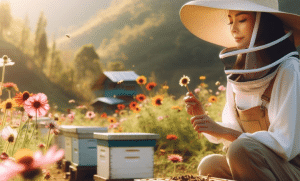
Beehive Management
Beehive management is an essential aspect of beekeeping that involves regular care and maintenance of the hive to ensure the health and productivity of the bees. Here are some key practices for effective beehive management:
- Basic Hive Inspection Techniques: Regularly inspecting your hive allows you to monitor the health and behavior of your bees. During inspections, you should look for signs of disease, check honey reserves, and ensure that the queen is laying eggs.
- Monitoring Bee Health and Behavior: Observing your bees’ behavior can provide valuable insights into their overall well-being. Look for signs of stress or aggression, as well as any unusual activity or patterns.
- Swarm Prevention: Swarming is a natural process in which a colony divides to form a new hive. However, too many swarms can weaken the original colony. To prevent swarming, provide enough space in the hive by adding supers or frames.
- Hive Pest Management: Pests such as varroa mites and wax moths can cause significant damage to bee colonies if left unchecked. Implement integrated pest management techniques to control pests effectively without harming your bees.
- Disease Control: Be vigilant in monitoring for common bee diseases like American foulbrood or chalkbrood. If any disease is detected, take appropriate measures like removing infected frames or treating with approved medications.
By implementing these practices into your beehive management routine, you’ll help ensure a thriving bee population and increase your chances of successful honey production.
Basic Hive Inspection Techniques
Regularly inspecting your beehive is crucial for the health and productivity of your bees. By conducting hive inspections, you can monitor the overall condition of your hive and take necessary steps to ensure its well-being. Here are some basic techniques for effective hive inspection:
- Timing: Conduct hive inspections every 7-10 days during the active season to catch any issues early on.
- Protective Gear: Wear appropriate protective clothing, including a beekeeping suit, gloves, and a veil, to minimize the risk of stings.
- Smoking the Hive: Use a bee smoker before opening the hive to calm the bees and make them less likely to sting.
- Observing Behavior: Observe how bees enter and exit the hive, as well as their flight patterns around it. Abnormal behavior may indicate disease or stress.
- Checking Frames: Gently remove frames from the supers (hive boxes) to inspect them for brood (eggs, larvae, pupae), honey stores, pollen reserves, and signs of pests or diseases.
- Queen Inspection: Locate the queen bee during inspections to ensure she is present and actively laying eggs in a healthy pattern.
- Record Keeping: Maintain detailed records of each inspection session, noting any abnormalities or actions taken so that you can track your hive’s progress over time.
Remember that proper technique is essential when handling bees during inspections. Be gentle and avoid sudden movements that may agitate them. With practice and experience, you will become more confident in managing your beehive effectively.
Monitoring Bee Health and Behavior
Monitoring the health and behavior of your bees is essential for maintaining a thriving hive. Regular observation allows you to detect any issues early on and take appropriate action to ensure the well-being of your colony.
When monitoring bee health, it is important to look out for signs of disease or stress. Observe how the bees enter and exit the hive, as well as their flight patterns around it. Abnormal behavior such as increased aggression or disorientation may indicate underlying problems.
During inspections, check the frames in the supers (hive boxes) for brood (eggs, larvae, pupae), honey stores, and pollen reserves. This will give you an idea of whether the queen is actively laying eggs in a healthy pattern and if there are enough food resources for the bees.
In addition to regular inspections, consider implementing a monitoring system such as using sticky boards or mite counts to assess varroa mite levels. These tiny pests can weaken colonies if left unchecked.
Maintain detailed records of each inspection session, noting any abnormalities or actions taken. This will help you track your hive’s progress over time and make informed decisions regarding its management.
By consistently monitoring bee health and behavior, you can intervene promptly when necessary and promote a strong and productive colony.

Harvesting Honey
Harvesting honey is one of the most rewarding aspects of beekeeping. Not only do you get to enjoy the sweet taste of your own homemade honey, but you also get to witness the fruits of your bees’ hard work.
To harvest honey, you will need some essential tools and equipment. These include a bee brush, uncapping knife or fork, a honey extractor, and jars for storing the harvested honey. It’s important to ensure that all your equipment is clean and free from any contaminants before starting the harvesting process.
Before extracting the honey from the hive, it’s crucial to remove any beeswax cappings that seal each cell containing the honey. This can be done using an uncapping knife or fork. Once the cappings are removed, place the frames into a honey extractor. The extractor uses centrifugal force to spin out the honey from the comb without damaging it.
After extracting the honey, allow it to settle in a settling tank or bucket for at least 24 hours. This allows any air bubbles or impurities to rise to the top for easy removal. Finally, strain or filter your harvested honey to remove any remaining debris before transferring it into clean jars for storage.
Remember to label your jars with important information such as date of harvest and type of floral source if known. Properly stored in a cool and dark place, your harvested honey can last indefinitely.
Harvesting honey is an exciting step in beekeeping that allows you to enjoy nature’s sweetest gift while also appreciating all that your bees have accomplished.
Harvesting Tools and Equipment
When it comes to harvesting honey, having the right tools and equipment is essential. Here are some key items you’ll need to ensure a successful harvest:
- Bee Brush: A bee brush is a gentle tool used to gently sweep bees off frames and away from the honeycomb during the harvesting process.
- Uncapping Knife or Fork: This tool is used to remove the beeswax cappings that seal each cell containing honey. An uncapping knife or fork makes it easier to access the honey for extraction.
- Honey Extractor: The honey extractor is a machine that uses centrifugal force to spin out the honey from the comb without damaging it. There are both manual and electric extractors available, depending on your preference and needs.
- Jars for Storage: Once you’ve extracted the honey, you’ll need clean jars with tight-fitting lids for storing your harvested honey. Glass jars are recommended as they are non-reactive and help maintain the quality of your honey over time.
Remember to clean all your equipment thoroughly before and after use to prevent any contamination or spoilage of your harvested honey.
By having these essential tools and equipment on hand, you’ll be well-prepared for a successful harvest of delicious homemade honey from your beehives.
Tips for Extracting and Storing Honey
Once you’ve harvested your honey, it’s important to properly extract and store it to maintain its quality and flavor. Here are some helpful tips:
- Uncapping: Use an uncapping knife or fork to remove the beeswax cappings that seal each cell of honeycomb. This will allow the honey to flow freely during extraction.
- Extraction Method: If you have a honey extractor, place the uncapped frames inside and spin them at a moderate speed to extract the honey using centrifugal force. For those without an extractor, crush and strain method can be used by crushing the comb with a clean utensil and straining out the liquid honey.
- Straining: After extraction, strain your honey through a fine mesh or cheesecloth to remove any remaining wax particles or other impurities.
- Settling: Allow your strained honey to settle in a clean container for several hours or overnight. This will help any air bubbles rise to the top, resulting in clearer honey.
- Storage Containers: Transfer your settled honey into clean glass jars with tight-fitting lids. Avoid using plastic containers as they can affect the quality of the honey over time.
- Labeling: It’s important to label your jars with the harvest date and type of flower source if known, so you can keep track of different batches and flavors.
- Storage Conditions: Store your jars in a cool, dry place away from direct sunlight to prevent crystallization and preserve its freshness.
By following these tips, you’ll ensure that your harvested honey is ready for consumption or gifting while maintaining its delicious taste and texture for months to come.

Dealing with Common Beekeeping Challenges
Beekeeping, like any other hobby or profession, comes with its own set of challenges. However, with proper knowledge and preparation, these challenges can be overcome. Here are some common beekeeping challenges and how to address them:
- Preventing and Managing Hive Pests: Pests such as varroa mites, wax moths, and small hive beetles can wreak havoc on your beehives. Regular monitoring and implementing pest management strategies like using screened bottom boards, applying natural treatments, and maintaining a clean hive environment can help keep these pests at bay.
- Addressing Beehive Diseases: Bees are susceptible to various diseases like American foulbrood and chalkbrood. Regular hive inspections to detect early signs of disease, practicing good hygiene by removing dead bees and debris from the hives, and treating infected colonies promptly can help prevent the spread of diseases.
- Queen Replacement: Sometimes queens may fail or need replacement due to age or poor performance. It is essential to recognize signs of queen problems such as decreased egg production or aggressive behavior in the colony. Introducing a new queen through methods like direct introduction or using queen cages can help maintain a strong colony.
- Weather Challenges: Extreme weather conditions like excessive heat or cold can impact bee colonies’ health and productivity. Providing shade during hot summers, insulating hives during winter months, ensuring adequate ventilation in the hive can help mitigate the effects of extreme weather.
Remember that each challenge presents an opportunity for growth as a beekeeper. By staying informed about best practices and seeking advice from experienced beekeepers or local beekeeping associations, you’ll be better equipped to handle these challenges effectively.
Preventing and Managing Hive Pests
One of the challenges beekeepers face is preventing and managing hive pests. Pests such as varroa mites, wax moths, and small hive beetles can cause significant damage to beehives if left unchecked. However, there are several strategies that beekeepers can employ to keep these pests at bay.
Regular monitoring is crucial in detecting pest infestations early on. By conducting routine hive inspections, beekeepers can identify signs of pest presence and take appropriate action. Using screened bottom boards can help trap and remove mites and beetles that fall through the screen.
Applying natural treatments is another effective method for pest management. Essential oils, such as thyme or lemongrass oil, have shown promise in repelling pests without harming bees or honey production. These treatments can be applied directly to the frames or added to sugar syrup for feeding.
Maintaining a clean hive environment also plays a vital role in pest prevention. Removing debris, dead bees, and excess honey from the hive helps eliminate hiding places for pests. Regularly replacing old comb can also reduce the risk of wax moth infestations.
It’s important for beekeepers to stay informed about the latest research and best practices for dealing with specific pests in their region. Local beekeeping associations and experienced beekeepers are valuable resources for guidance and support in managing hive pests effectively.
By implementing these strategies and staying proactive in pest prevention, beekeepers can ensure healthier hives and thriving colonies.
Addressing Beehive Diseases
Beehive diseases can pose a significant threat to the health and survival of your bee colonies. It is essential for beekeepers to be able to identify and address these diseases promptly. Here are some common beehive diseases and how to manage them:
- American Foulbrood (AFB): AFB is a highly contagious bacterial disease that affects larvae. Infected larvae turn dark brown or black, with a foul odor. To control AFB, affected frames should be burned, and infected colonies must be destroyed.
- European Foulbrood (EFB): EFB is also caused by bacteria but has less severe symptoms than AFB. Affected larvae exhibit a twisted appearance and may have a yellow coloration. Treating with antibiotics like oxytetracycline can help control EFB.
- Nosema: Nosema is a fungal disease that affects adult bees’ digestive systems, leading to reduced lifespan and weakened immune function. Medications such as fumagillin can be used to treat Nosema.
- Varroa Mites: While not technically a disease, varroa mites are parasitic pests that weaken bees by feeding on their blood and transmitting viruses. Regular monitoring, along with treatments like formic acid or oxalic acid vaporization, can help manage varroa mite infestations.
- Chalkbrood: Chalkbrood is a fungal infection that affects bee larvae, causing them to become chalk-like in appearance before dying off completely. Good hive hygiene practices, such as maintaining proper ventilation and reducing moisture levels in the hive, can help prevent chalkbrood.
It’s crucial to stay vigilant by conducting regular hive inspections for signs of disease or pest infestations so you can take appropriate action promptly.

keeping bees
Beekeeping is a rewarding and fulfilling hobby that not only benefits the environment but also provides you with delicious honey and beeswax. By following the basics of beekeeping, you can successfully maintain healthy bee colonies and enjoy the many rewards they bring.
Throughout this beginner’s guide, we have covered essential aspects of beekeeping, from choosing the right hive equipment to harvesting honey. We have also discussed how to prevent and manage common challenges such as hive pests and beehive diseases.
It is important to remember that beekeeping requires dedication and regular maintenance. Conducting routine hive inspections, monitoring bee health, and addressing any issues promptly are crucial for successful beekeeping.
While there may be challenges along the way, the satisfaction of watching your bees thrive and enjoying the fruits of their labor makes it all worthwhile. Beekeeping not only allows you to connect with nature but also contributes to pollination efforts in your local ecosystem.
To further expand your knowledge on beekeeping, there are plenty of additional resources available for beginner beekeepers. Online forums, books, local workshops, and experienced mentors can provide valuable guidance as you continue your journey in keeping bees.
So why wait? Start your adventure in beekeeping today and experience firsthand the joy of tending to these incredible insects while reaping sweet rewards from their hard work.
Celebrating the Rewards of Beekeeping
Beekeeping is a truly rewarding endeavor that offers numerous benefits. As a beekeeper, you get to witness the fascinating lives of bees up close and personal. The joy of watching your colonies thrive and grow is incomparable.
One of the greatest rewards of beekeeping is the delicious honey produced by your bees. Harvesting your own honey not only provides a sweet treat for you and your family but also allows you to share it with friends and neighbors, spreading the love for nature’s golden nectar.
In addition to honey, beekeeping also yields another valuable product: beeswax. Beeswax can be used in various ways, from making candles and lip balms to creating natural skincare products. It’s a versatile material that showcases the incredible work of bees.
Furthermore, keeping bees contributes to pollination efforts in your local ecosystem. By providing habitat and support for these vital pollinators, you are helping to ensure the health and diversity of plant life in your area.
Beyond tangible rewards, beekeeping offers an opportunity for personal growth and connection with nature. It teaches patience, observation skills, and respect for these remarkable creatures. Beekeepers often form communities where they can share knowledge, experiences, and even surplus hive products.
So whether it’s enjoying freshly harvested honey on warm toast or marveling at the intricate beauty of beeswax creations, celebrating the rewards of beekeeping is an experience like no other. So why not embark on this journey today? Start keeping bees and immerse yourself in the wonders they have to offer
Additional Resources for Beginner Beekeepers
As a beginner beekeeper, it’s important to have access to reliable resources that can help you navigate the world of beekeeping. Here are some additional resources that can provide valuable information and support:
- Beekeeping Associations: Joining a local or regional beekeeping association can connect you with experienced beekeepers who can offer guidance and advice. These associations often hold meetings, workshops, and educational events to help beginners learn more about beekeeping.
- Books: There are many informative books available that cover all aspects of beekeeping, from hive management to honey extraction techniques. Some recommended titles for beginners include “The Beekeeper’s Handbook” by Diana Sammataro and Alphonse Avitabile, “Beekeeping for Dummies” by Howland Blackiston, and “The Backyard Beekeeper” by Kim Flottum.
- Online Forums and Communities: Participating in online forums and communities dedicated to beekeeping allows you to connect with other hobbyists, ask questions, share experiences, and learn from their knowledge. Websites such as Beesource.com and Beemaster.com offer active forums where you can interact with fellow beekeepers.
- Local Extension Offices: Contact your local agricultural extension office or university cooperative extension program for information on educational workshops, classes, and resources specific to your area.
Remember that learning about bees is an ongoing process, so don’t hesitate to explore these additional resources as you continue on your journey as a beginner beekeeper.
Is it difficult to keep bees?
Keeping bees can be both challenging and rewarding, especially for beginners. While it may seem daunting at first, with the right knowledge and preparation, beekeeping can become a fulfilling hobby.
One of the challenges of beekeeping is understanding the complex nature of a bee colony. You need to learn about their behavior, needs, and how to effectively manage their hive. This requires ongoing education and observation to ensure the health and productivity of your bees.
Another challenge is managing potential risks such as pests and diseases that can affect your hive. Regular inspections are necessary to identify any issues early on and take appropriate measures.
However, with proper guidance from experienced beekeepers or resources like books and online forums, you can overcome these challenges. Beekeeping associations provide support networks where you can learn from experienced enthusiasts who are willing to share their knowledge.
It’s important to note that while there is a learning curve involved in beekeeping, it becomes easier over time as you gain experience and confidence in handling your bees. With patience, dedication, and a genuine interest in caring for these incredible insects, you’ll find that keeping bees can be an immensely rewarding endeavor.
Are bees worth keeping?
Absolutely! Keeping bees can be incredibly rewarding and beneficial for both the environment and yourself. Here are some reasons why bees are worth keeping:
- Pollination: Bees play a crucial role in pollinating plants, which helps to ensure the production of fruits, vegetables, and flowers. By keeping bees, you contribute to the health and abundance of your garden or surrounding landscapes.
- Honey Production: One of the main benefits of beekeeping is harvesting your own delicious honey. Not only does it provide a natural sweetener for your meals and beverages, but it also has numerous health benefits and can be used for various purposes like making skincare products or candles.
- Connection with Nature: Beekeeping allows you to connect with nature on a deeper level by observing the fascinating behavior of bees and their intricate hive system. It provides an opportunity for mindfulness and learning about the natural world around us.
- Sustainability: By maintaining bee colonies, you contribute to biodiversity conservation efforts as honeybees play a vital role in maintaining ecosystems’ balance.
- Personal Satisfaction: Beekeeping offers a sense of accomplishment as you learn how to care for these remarkable creatures and witness their thriving colony under your guidance.
While there may be initial challenges in learning how to keep bees effectively, the rewards far outweigh them. With proper knowledge, equipment, and ongoing commitment to hive management, beekeeping can bring joy, connection with nature, delicious honey harvests, and positive environmental impact into your life.
Is beekeeping an expensive hobby?
Beekeeping can be as affordable or as expensive as you make it. The initial startup costs can vary depending on the equipment and bees you choose, but once you have your hive set up, the ongoing expenses are relatively minimal.
To give you an idea of the costs involved, here is a breakdown of some common expenses:
- Hive Equipment: This includes items like the hive boxes, frames, foundation, and protective gear for yourself. Prices can range from $200 to $500 for a basic setup.
- Bees: The cost of purchasing bees can vary depending on factors such as the type of bees and whether you buy a package or a nucleus colony (nuc). On average, buying a nuc will cost around $150 to $200.
- Maintenance Supplies: You’ll need to invest in some basic maintenance supplies like feeders and medications for bee health. These costs are generally low and will depend on your specific needs.
- Education: It’s always recommended to attend beekeeping classes or workshops to gain knowledge and skills. While these classes may have fees associated with them, they are invaluable investments in your success as a beekeeper.
While there are ongoing expenses involved in keeping bees, such as occasional replacement equipment or feeding supplements during periods of low nectar flow, these costs are manageable and should not deter anyone from pursuing this rewarding hobby.
Remember that beekeeping also has potential financial benefits! Besides enjoying your own delicious honey harvests, you may have opportunities to sell excess honey or other hive products like beeswax candles or skincare items, which could help offset some of your initial investment costs.
Overall, while there is an upfront investment required for equipment and bees, beekeeping can be pursued at various budget levels without breaking the bank. With proper planning and budgeting, it is indeed possible to enjoy this fascinating hobby without significant financial strain.
Is keeping bees a daily thing?
Keeping bees does require regular attention and care, but it doesn’t necessarily mean that you have to tend to your bees every single day. The frequency of beekeeping tasks can vary depending on the time of year and the specific needs of your hive. Here are some key points to consider:
- Seasonal Variations: During certain times of the year, such as spring and summer when bees are most active, you may need to check on your hive more frequently. This could involve inspecting for signs of disease or pests, monitoring honey production, and ensuring a healthy environment for the bees.
- Routine Maintenance: Regular maintenance tasks include cleaning and repairing equipment, providing supplemental feeding if necessary, and managing any swarming behavior.
- Observational Monitoring: It’s important to observe your hive regularly to ensure that the bees are behaving normally and there are no signs of distress or illness. This can be done by simply watching their activity at the entrance of the hive.
- Harvesting Honey: Harvesting honey is a rewarding part of beekeeping but typically occurs only once or twice a year, depending on local climate conditions and honey production levels.
While keeping bees does require consistent effort and attention, it is possible to develop a routine that fits into your schedule without it becoming an overwhelming daily commitment. Many beekeepers find joy in observing their hives’ progress while still balancing other responsibilities in their lives.
I hope this beginner’s guide to keeping bees has provided you with a solid foundation to start your own beekeeping journey.
Remember, beekeeping is not only beneficial for the environment but also rewarding and fulfilling. If you have any questions or would like to share your own experiences, feel free to leave a comment below. Happy keeping bees!



